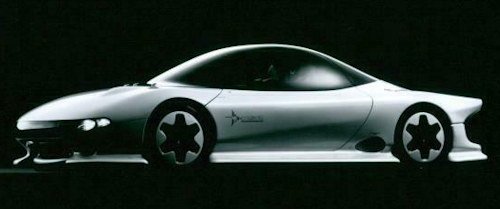Mitsubishi HSR concept cars
 |
|
|
Manufacturer |
Mitsubishi |
|
Production |
1987 to 1997 |
|
Class |
Concept |
|
Layout |
2-door coupe,roadster |
Mitsubishi HSR (Highly Sophisticated-transport Research) is a series of concept cars that Mitsubishi Motors displayed for ten years in the late 1980s and early 1990s.
History
Mitusbishi Motors has conducted Advanced Research through the state—of-the-art HSR series since 1987.The HSR, which debuted in 1987, was the first. It demonstrated Mitsubishi's integrated electronic system, which provided autonomous management of the drive train, steering, driving position, and brakes in response to weather and driving circumstances. A turbocharged 2-liter engine with approximately 300 horsepower drove the vehicle. The top speed was believed to be around 300 km/h. The first iteration meant Hi-speed Running Research, the second Hi-Sophisticated Research, and the third Human Science Research.
The vehicle was released in six different iterations every two years to coincide with the Tokyo Motor Show, with each model following the original being distinguished by a Roman numeral suffixed to the name. The acronym's meaning has changed throughout time.
Models 1980s

HSR (1987) — The first vehicle was a showcase for Mitsubishi's integrated electronic systems offering automatic control of drive train, suspension, steering, brakes, and driving position according to driving conditions or weather.The HSR (High Speed Research) concept vehicle. developed by Mitsubishi Motors Corp. , represents the integration Of state of the art technologiesas a rolling research laboratory for the of the generation of Mitsubishi passenger vehicles. Capable Of speeds of Over 200 mph, the HSR shares many of the pcwertrain, suspension and componentry found in the 1989 Galant, marketed by Mitsubishi Motor Sales Of It was powered by a 2.0-litre 16-valve turbocharged engine producing 295 PS (217 kW), had a maximum speed claimed by the factory at 300 km/h (186 mph).

HSR-II (1989) — The second generation had a heavy emphasis on active aerodynamics, with a series of movable fins and spoilers offering a drag factor which varied from 0.20 to 0.40 depending on setup. Much of the technology found its way to the Mitsubishi HSX, the precursor to the company's GTO sports car.
Models 1990s

HSR-III (1991) — The third concept car to bear the HSR name was powered by the 180 PS (132 kW) 6A10 1.6-litre V6, the world's smallest mass-produced V6. Its design themes were "Human Scale Technology" and "Small is beautiful." It continued the active aerodynamics theme of the HSR-II, but with the addition of flexible skin on the rear spoiler, dubbed an "elastic aerotail." Shifting from the overtly sporting and powerful earlier HSRs, the HSR-III also focused on cleanliness and recyclability - with the body parts all marked for ease of recycling.
HSR-IV (1993) — A 180 PS (132 kW) modulated displacement version of the 1.6-litre V6 DOHV powered the fourth prototype, a four-wheel-drive sports car featuring an all-wheel anti-lock braking system .A co drag of 0.20.
With HSR-IV - which focuses on the three-way relationship between the driver, the car, research into and the driving environmentperformance and safety has reached new heights. AI of HSR—IV's key components incorporate Artificial Intelligence which gives HSR-IV the ability to learn and adapt to each individual driver's style. The source of the HSR-IV's power is the 1.6 litre V6 DOHC 24-valve MI VEC engine with Modulated Displacement that offers superb fuel efficiency by shutting down when possible- such as when running at a constant speed - the operation of the intake and exhaust valves on 3 of the 6 cylinders.
4-wheel drive, 4-wheel independent braking system (including ABS) and 4-wheel multi-link suspension give HSR-IV a sure-footed feel.To reduce stress and allow the driver to concentrate, a simply designed, easy to see Head Level Display is positioned clearly within the driver's
line of sight.

HSR-V (1995) — The fifth generation, a Targa topped sports car with a folding hardtop roof, featured the debut of Mitsubishi's gasoline direct injection (GDI) technology in its ICDIGE engine.Biodynamic Suspension II consists Of a 4 wheel link suspension and an auto vehicle height system that
adjusts the ride height over a 150mm range for outstanding performance on all driving surfaces. To the caster and camber control that were available on HSR-IV, Biodynamic Suspension II adds an alignment control system to adjust the attitude Of all four tyres, enabling superlative performance under all driving conditions. Mitsubishi has also created the world's first Active Yaw Control System to ensure precise cornering and reduce the risk of spinning. This is composed of 4 wheel steering, 4 wheel independent brake control the world's first torque transfer differential. which transfers drive ENGINE
Fuel System force between the left and right wheels.
HSR-VI (1997) — Fitted with a 2.4-litre version of the GDI engine, the sixth HSR concept featured four-wheel steering, active yaw control, traction control and an automated driving system
Manuals
Media
Mitsubishi HSRV concept car (1987)
Author Motor car History Duration 03:23-
Mitsubishi Previous 30 / 55 Next
